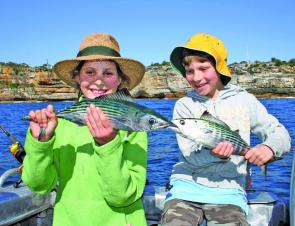After a very slow start to the season, the surface fish have finally arrived with a vengeance.
The action went from virtually nothing to carnage over two days.
Salmon are working hard on top, with the bonito around and underneath them and trevally sitting even deeper.
Scattered over a large area are hordes of bonnies, working singly or in small schools.
A bit further into the Harbour, the tailor are on the job. Shack Bay and Washaway Beach have bonito and up around Goat Island there is a mix of all of the above.
I’ve also had reports that the kingfish have left Long Reef, which means that they should show up in the Harbour any day now.
Salmon and bonito feed differently when they are working the surface bait.
Bonito slash at the bait in a U-shaped sweep. From well under the surface, they charge upwards, hit the bait on the surface and quickly dart back to the depths.
Salmon stay on top, chomping along the surface, usually all in one direction, herding the baitfish along as they go.
Salmon rely more on inhaling their prey, where bonito work more on a slash-and-grab technique. A comparison of their mouth shapes and teeth will verify that there's some truth in that theory.
So generally the splash left by a bonito will be more prominent than that of a salmon.
With practice, you can learn to identify the species from the way in which they are breaking the surface, even if you can’t visually identify the fish.
Tailor and bonito both attack in much the same way, a long slash that creates a big spray and flying baitfish.
Kings and salmon are much more subtle, leaving a boil or swirl that is less detectable from a distance.
How will knowing this make a difference?
Different species respond to different types and sizes of lures, varied retrieve rates and styles and different approaches.
Making a decision on these variables is obviously much easier if you know what you are chasing.
I'll give you an example of a common mistake that costs fish.
There were a number of boats fishing the same surface school around North Head early one weekend morning. Everyone was catching bonito but we were the only ones catching salmon.
When we got back to the boat ramp at Roseville we met up with one of the anglers from another boat that had been working the school alongside us. He asked us if we had ever seen so many bonito working the surface like that before.
When I informed him that the fish working the surface were actually salmon he became agitated and told me that, being a fishing guide, I should know better. He then held up half a dozen bonito to confirm his claim. I left it at that.
He had been working the surface with a chrome lure about 8cm long. When that failed, he did the right thing and tried on a deep-diving minnow. Straight away he started catching bonito, concluding that the fish churning the surface were bonito and he had found the right lure.
We had also caught a few bonito by letting our tiny chrome lures sink well below the surface action. The salmon churning the surface were by no means easy to catch but if you put in enough casts with very tiny lures and retrieved them fast, very close to the surface, one would eventually succumb.
When they are feeding like this salmon will, with persistence, take a tiny lure or fly retrieved across the top. They will never take a large lure retrieved across the top, let alone underneath them.
Our mate at the ramp presented his lure deep, within easy reach of the bonito and with a lure size that was acceptable to them.
Unlike salmon, bonito readily accept a variety of lure sizes regardless of the size of the bait they are feeding on.
It’s common to find a number of pelagic and demersal species working under surface-feeding fish. Whether you are catching the fish that are working on the surface or not, it’s always worth letting your lure fall deep occasionally.
The trevally at the Heads have been working the layer below the bonito, which were in turn below the salmon. This led some anglers to believe the fish working the surface were trevally when they were actually salmon.
Trevs generally prefer the small lures favoured by salmon, although we have occasionally taken them on poppers and average-sized diving minnows.
You can see from the above scenario that to effectively work this situation you must use a variety of lures worked at a variety of depths at different retrieve speeds.
The scattered bonito have been too easy to catch by simply trolling Rapala CD 7 minnows 30m behind the boat at about four knots. They have been so thick that nobody seems to be missing out.
Like bonito, tailor are much less fussy about lure size but the best results always come from matching the hatch.
Unlike bonito, they are commonly found on the surface so they are generally easier to locate.
In the right conditions bonito will work the surface but less commonly than many other pelagics.
A high-speed retrieve is less essential for tailor, salmon and trevs than it is for members of the tuna family, like bonito.
Reads: 2462
Tailor are on the job in Sydney Harbour, slashing into the bait.

Bonito aren’t commonly found on the surface and are less choosy about the lure size than salmon.

You can’t see the fish but can you tell by their feeding splashes what they are and how to target them? And are there other species underneath?




